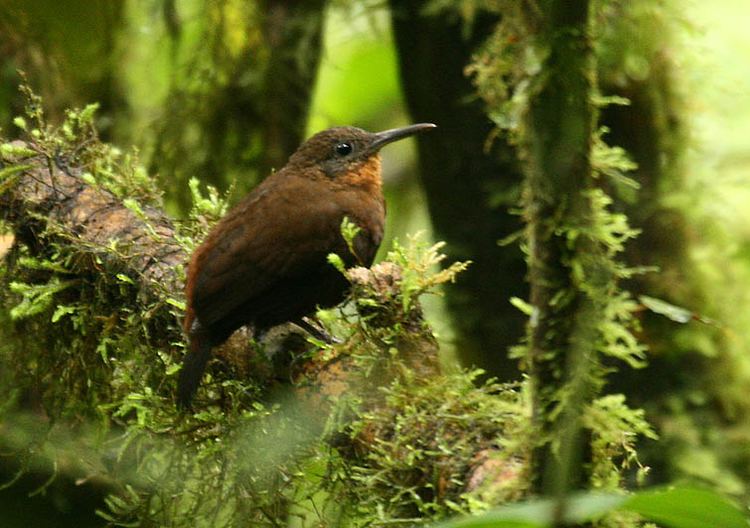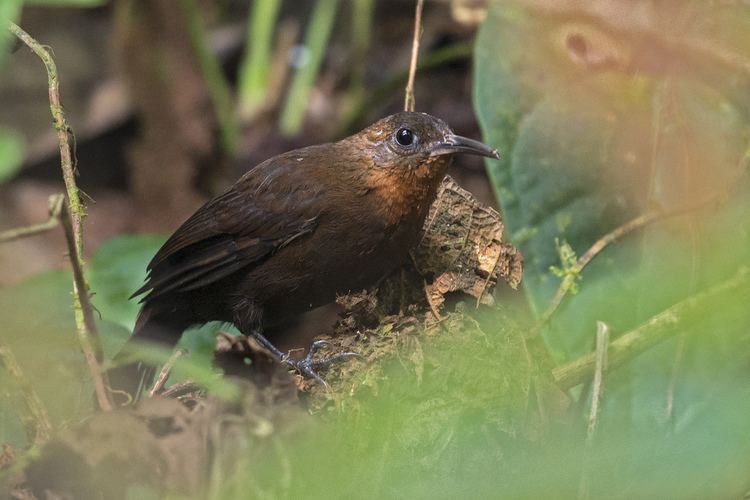Order Passeriformes Subfamily Sclerurinae Rank Species | Phylum Chordata Family Furnariidae Genus Sclerurus Higher classification Sclerurus | |
 | ||
Similar Short‑billed leaftosser, Scaly‑throated leaftosser, Ruddy foliage‑gleaner, Bird, Slaty spinetail | ||
Tawny throated leaftosser sclerurus mexicanus www colombiabirding com
The tawny-throated leaftosser (Sclerurus mexicanus) is a tropical American bird species in the ovenbird family Furnariidae. It is also known as the tawny-throated leafscraper, Mexican leaftosser or Mexican leafscraper. This bird might be a cryptic species complex.
Contents
- Tawny throated leaftosser sclerurus mexicanus www colombiabirding com
- Tawny throated leaftosser sclerurus mexicanus 1 carmen de atrato w andes
- Description
- Systematics
- Subspecies
- Range and ecology
- References

Tawny throated leaftosser sclerurus mexicanus 1 carmen de atrato w andes
Description
This roughly thrush-sized bird measures 15–17 cm in length and weighs 24–30 g. Its coloration is quite uniformly a rich chestnut brown. The tail is darker, the breast, rump and head are lighter and tinged rufous, though the crown and cheek region are as dark as the body, with some greyish hue to the cheeks. Its iris is dusky brown, the feet are blackish brown. The bill is very long and thin, perhaps by proportion the longest and thinnest of all Furnariidae. It is blackish brown above, and whitish, horn-colored or dark grey below; the tip is black.
Males and females look alike. Young birds are duller, with light streaks and dusky scaling on throat and breast.

The song of the tawny-throated leaftosser is a series of 4–9 wheezy notes which descend, accelerate and fade out as they are given: peeeeee-peeeee-peeee-chrrrr. For some populations, slightly different songs have been described; subspecies pullus produces a series of sharp squee calls or a whistling pseeer-pseer-pseer-psee-pse, while subspecies peruvianus has a series of clear suweet whistles and its song often ends in a trill. It is not clear whether these vocalizations indicate specific distinctiveness, but it is notable that at least in peruvianus the song often ends with a "flourish" and does not quietly fade out as it does in the northern populations.
The alarm call is a sharp chick, squee, tseeéét or zick.

The short-billed leaftosser (S. rufigularis) is widely sympatric in the Amazonas basin. It looks almost alike but it has a shorter bill and its song, while structured similarly, changes in pitch several times through its course rather than simply descending. It is also an inhabitant of terra firme forest near rivers, whereas the tawny-throated leaftosser prefers hilly terrain.
Systematics

The tawny-throated leaftosser is considered to be the sister species of the short-billed leaftosser (S. rufigularis). It might actually contain two species which are sympatric by range (though not by altitude) between eastern Panama and northern Colombia; the birds between Meta and Santander Departments (Colombia), including a population in the Serranía de las Quinchas discovered only on January 20, 2006, have not been identified as to subspecies yet. As regards scientific names, S. mexicanus would refer to the lowland birds, while the name of the Andean ones (which ironically would not include the subspecies andinus, essentially a lowland bird despite its name) would be S. obscurior. The status of the isolated Mata Atlântica population is also unclear; it might represent yet another species, which would be named S. bahiae, but it has been very little studied.
Subspecies
As long as the species is not split up, seven subspecies, differing in appearance quite markedly for such a plain bird, are recognized.
mexicanus group:
obscurior group:
Incertae sedis:
Range and ecology
The tawny-throated leaftosser ranges from southern Mexico through Central America into Colombia, and from there south to the Peruvian Andes as well as southeast to the Amazon Basin, with an isolated population in the Atlantic Forest of Brazil. The species is largely absent from Venezuela and is patchily distributed across most of its range, particularly Central America. Its natural habitats are tropical moist lowland forests and tropical moist montane evergreen forests. It prefers hilly terrain, occurring mainly between 700 and 2,200 m ASL in Central America, and from near sea level to 1,500 m and locally to 2,000 m ASL in South America.
The species lives on the ground, where it feeds on invertebrates found by flicking through leaf litter, digging in moist soil or in rotting wood, often using the tail to anchor itself; the tips of the rectrices become abraded by this behavior and before moult often just the resilient feather shafts remain. Tawny-throated leaftossers are encountered singly or in pairs; they may be attracted by recordings of their alarm calls. These birds typically move by hopping about and are reluctant to fly if they do not have to. They are not migratory.
Tawny-throated leaftossers are assumed to be monogamous and are territorial, with their territories that are around 25 ha in size. The breeding season – if this species actually has a well-marked breeding season – is prolonged, running at least from December to April in Costa Rica; breeding activity was recorded in April/May for Colombia and in August for Ecuador. The nest is a small cup, loosely woven from dry twigs and leaf remains, in a cavity up to 20 cm in diameter at the end of a tunnel – up to 50 cm long but often much shorter – dug into an earth bank or similar spot. Little is known about their breeding biology, but they presumably lay two eggs per clutch.
It is generally an uncommon bird, with a population density usually less than (and often far less than) 5 individuals per square kilometer. It quickly disappears from forests that have been fragmented due to logging, and will not even tolerate selective logging well. Due to its large overall range, it is classified as a Species of least concern by the IUCN; if it is split up into two or three species however, the Andean and Atlantic Forest populations are likely to qualify as threatened species.
